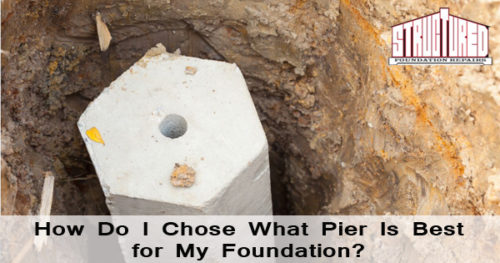Types of Underpinning for Foundation Repair

Two Types of Underpinning
Extensive foundation issues will likely call for some type of underpinning for an effective repair. Underpinning is defined as a solid foundation laid below ground level to support or strengthen a structure. Basically, if your home’s foundation is considerably imbalanced, you will need underpinning. To enlighten you, let’s go in-depth with the types of underpinning:
Piering– Technique of installing concrete/steel pilings into the ground to support a foundation
Piering is the biggest project between the two underpinning foundation repair methods. It requires significant excavation and the use of specific machinery. While there is a chance each pier can be installed through tunneling (pathways dug beneath a home), repairmen will more than likely have to install piers from within your Euless, TX home. Though, that may depend on the type of pier.
Generally speaking, there are three types of piers used to level a foundation:
Concrete Piers
Concrete piers are either pre-casted and installed or cast in place at the foundation location. They are meant for highly-compressed areas and their essential purpose is to create a new foundation level. Given the fact that concrete piers are consistently between two-to-three feet in length, there is a chance they can be installed via tunneling. Their short length makes them cheaper than other piering materials.
But, here’s the catch…
Cheaper is good; however, the lower cost comes with a reason. Concrete is, of course, an extremely strong material, but because concrete piers are relatively short and can only be driven into the ground a short way, the pressure of the soil within the foundation may cause the concrete piers to shift over time. They should still stay in place for a good 20 years, but you may run into another foundation issue eventually.
Steel Piers
Piers made of steel are more expensive because they can be forced into the ground as far as the bedrock (beneath all of the soil). The installation of steel piers should result in a solid, unphased foundation for the rest of a home’s life.
Ultimately, steel piers also aim to create a new level of foundation, but they do so more effectively and permanently than concrete piers. Steel piers are much longer and will, therefore, take more time and effort to install. The installation will be messier, though, well worth it. Plus, foundation repair experts will work to get your flooring back to normal once the repair is complete.
Helical Piers
Helical piers are both similar and completely different from their counterparts. They liken steel piers in the sense that they can be drilled all the way to the bedrock. The shape of a helical pier; however, is completely different from both concrete and steel piers.
Helical piers have ridges like a screw. They take up much less space within the ground and are easier to force into the ground. The use of helical-type piers is becoming more and more common in today’s foundation repair.
Rely on the foundation expert to tell you which type of pier is necessary for your specific foundation repair. He/she will assess the problem and determine a plan of attack with the chosen pier.
Mudjacking- Pumping concrete into the soil beneath a structure in order to level the structure
The second of the two types of underpinning is mudjacking. Mudjacking, otherwise called slab jacking, is a much simpler process. The process requires very little excavation if any at all. Experts will drill holes into the foundation to create pathways for concrete or polyurethane to be pumped into. The two options triumph soil being pumped back into the foundation. Pumping soil back into the soil will only lead to the same problem down the road.
While mudjacking is not considered to be a permanent fix, it will resolve the foundation issue for a lengthy time period. Concrete and polyurethane are reliable, strategic substances that aren’t just meant to fill the areas that lack soil, but also seal and stabilize the surrounding soil. Mudjacking is not creating a new foundation level. Rather, it fixes the present foundation.
There you have it—your two types of underpinning that may or may not apply to your home’s foundation. With that said, if you are under the suspicion that your Euless, TX home foundation is in trouble, contact Structured Foundation Repairs at 972-484-1200. Our professional foundation repair crew will be able to pinpoint the issue immediately and we will be able to execute the necessary repair! For additional helpful foundation input, please visit our blog.
